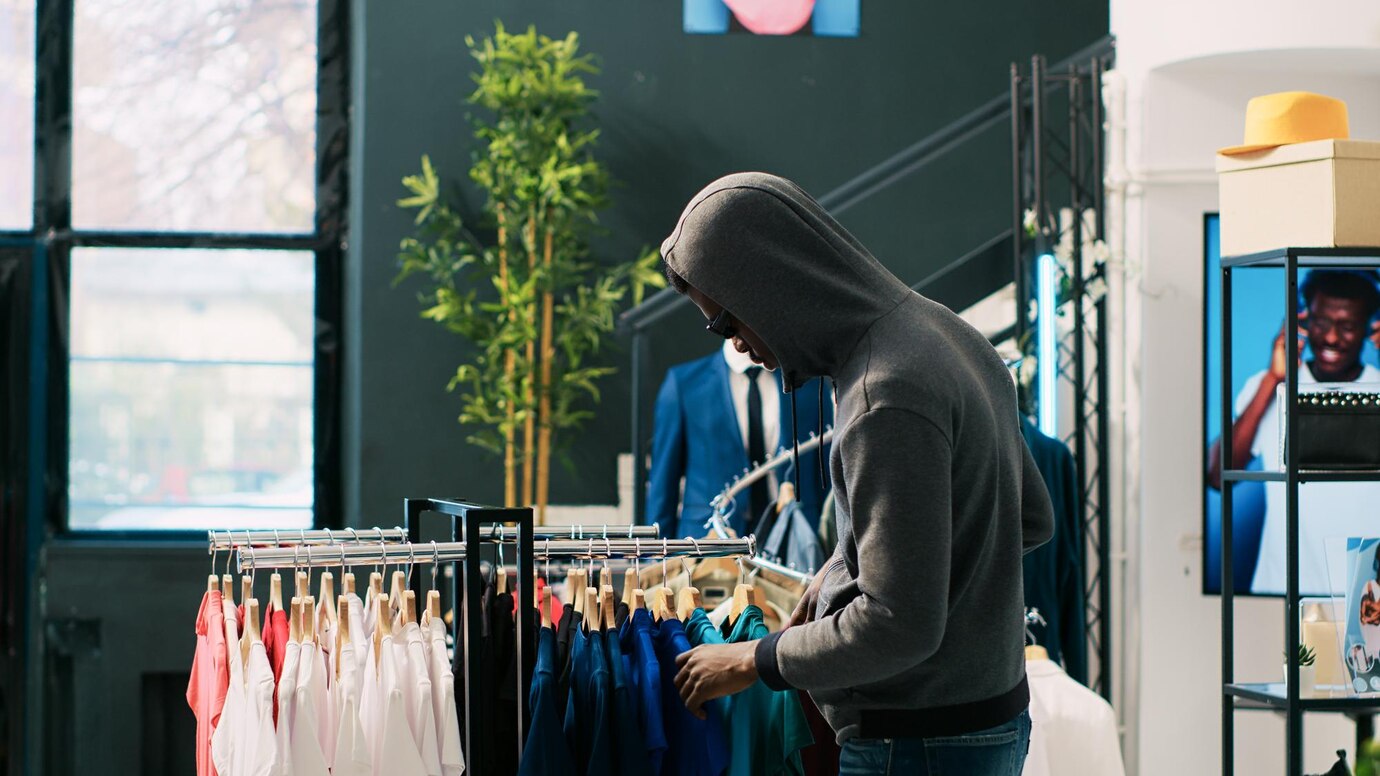
How to Prevent Retail Theft and Loss Prevention Strategies
Retail theft is a major issue for businesses everywhere. Shoplifting, employee theft, and fraud can all lead to significant losses. Effective retail loss prevention measures help keep stores profitable and ensure a safe shopping experience for customers and employees.
With the right shoplifting prevention techniques and solid security measures in stores, retailers can reduce shrinkage, deter crime, and enhance overall security. This guide outlines effective strategies to prevent retail theft and protect store assets.
Quick Guide: Retail Theft Prevention Essentials
- Train staff to recognise and respond to suspicious behaviour
- Use CCTV, mirrors, and EAS systems to monitor and deter theft
- Redesign store layout to minimise blind spots and improve visibility
- Secure high-risk items and monitor POS for internal theft
- Enforce strict return policies and collaborate with law enforcement
- Stay alert to organised retail crime and return fraud
Pro Tip
Greet every customer who walks in. Friendly engagement not only improves customer service—it also deters shoplifters who prefer to go unnoticed.
Important
Shrinkage from theft isn’t just a cost issue—it can erode team morale and customer trust. Proactive prevention is a long-term investment in both security and brand integrity.
The Impact of Retail Theft on Businesses
Retail theft causes major financial losses, which affect pricing, profits, and customer satisfaction.
Common Consequences of Retail Theft:
- Revenue Loss: Theft cuts into profits, leading to higher prices.
- Reduced Customer Trust: Shoppers feel uneasy in stores with frequent theft.
- Employee Morale Issues: Staff may feel demotivated in an unsafe environment.
- Operational Disruptions: Stores waste time addressing theft instead of focusing on sales.
By adopting strong retail loss prevention measures, businesses can avoid these issues and ensure success.
Common Types of Retail Theft
Recognising different types of theft helps retailers use effective security measures in stores to combat specific threats.
1. Shoplifting
Shoplifting is a common crime where people steal items without paying.
Shoplifting Techniques:
- Hiding items in bags or clothing.
- Switching price tags for lower prices.
- Distracting staff while others steal.
- Returning stolen goods for store credit.
2. Employee Theft
Employee theft happens when staff steal money, and products, or manipulate sales.
Common Forms of Employee Theft:
- Under-ringing or giving unauthorised discounts to friends.
- Stealing cash from the register.
- Taking products without paying.
- Falsifying inventory to hide theft.
3. Organized Retail Crime (ORC)
ORC involves groups that steal high-value items for resale.
Signs of ORC Activity:
- Large thefts of popular items like electronics or designer clothes.
- Groups quickly grab many items.
- Using stolen credit cards or fake money.
4. Return Fraud
Return fraud occurs when people return stolen or fake items for refunds.
Types of Return Fraud:
- Using stolen receipts to return items.
- Buying, using, and returning items (wardrobing).
- Returning counterfeit or damaged products.
Identifying these threats helps retailers create tailored shoplifting prevention strategies.
Best Retail Loss Prevention Strategies

1. Train Employees on Theft Prevention
Employees are key to retail loss prevention. They can spot suspicious behaviour and follow security protocols.
Training Tips for Retail Staff:
- Teach how to recognise shoplifting signs.
- Encourage friendly customer service to deter theft.
- Train cashiers to spot fraudulent transactions.
- Educate staff on loss prevention reporting.
Well-trained employees are the first line of defence against theft.
2. Install Security Cameras and Surveillance Systems
CCTV cameras are effective security measures in stores to discourage and detect theft.
Best Practices for Security Cameras:
- Place cameras at entrances, exits, and high-theft areas.
- Use high-definition cameras with remote access.
- Display clear security signs to deter thieves.
- Regularly review footage for suspicious activity.
Visible surveillance can significantly cut down on theft.
3. Use Electronic Article Surveillance (EAS) Systems
EAS systems help prevent theft by attaching security tags to items.
How EAS Systems Work:
- Security tags are on high-value items.
- Alarms sound when tagged items go through exit sensors without deactivation.
- Staff remove or deactivate tags at checkout.
Retailers using EAS systems often see fewer theft incidents.
4. Implement Store Layout Strategies to Prevent Theft
Smart store designs can deter theft and improve visibility.
Effective Store Layout Strategies:
- Position checkout areas near exits for better monitoring.
- Use mirrors to eliminate blind spots.
- Keep the store clean to spot suspicious behaviour.
- Place high-value items in locked cases.
Well-planned layouts make it harder for thieves to steal unnoticed.
5. Increase Employee Presence and Customer Engagement
Thieves are less likely to act when they see attentive staff.
How to Enhance Employee Presence:
- Train staff to greet customers as they enter.
- Have employees patrol high-theft areas.
- Use undercover security to watch for suspicious behaviour.
- Schedule staff to cover all store sections.
Active engagement helps deter theft and improves customer service.
6. Implement Strict Cash Handling Procedures
Preventing cash theft is key to reducing losses from internal theft.
Best Cash Management Practices:
- Limit cash in registers and make frequent deposits.
- Require manager approval for refunds and voided transactions.
- Monitor point-of-sale (POS) for suspicious cash handling.
- Use locked cash drop boxes for large transactions.
Secure cash handling prevents employee theft and fraud.
7. Enforce a Strong Return Policy to Prevent Fraud
Clear return policies can stop return fraud.
Anti-Fraud Return Policy Measures:
- Require proof of purchase for all returns.
- Limit returns on high-theft items like electronics.
- Use serial number tracking for expensive products.
- Implement restocking fees for frequently returned items.
A strong return policy prevents fraudsters from exploiting loopholes.
8. Collaborate with Law Enforcement and Retail Networks
Working with law enforcement and industry groups enhances theft prevention.
Collaboration Strategies:
- Report repeat offenders to local authorities.
- Share theft trends with other retailers.
- Join organized retail crime (ORC) prevention programs.
- Ban known shoplifters from stores.
Partnering with external security experts strengthens overall retail loss prevention efforts.
FAQs: Retail Loss Prevention
1. What is shrinkage in retail?
Shrinkage refers to inventory loss due to theft, fraud, damage, or errors. It directly impacts profit margins and must be actively managed.
2. What’s the most common type of retail theft?
Shoplifting is the most common, followed by employee theft. Both require different strategies—customer-focused deterrents and internal controls.
3. How do EAS systems work?
EAS tags are attached to merchandise. If not deactivated at checkout, they trigger an alarm when passing through exit sensors.
4. Can store layout really prevent theft?
Yes. A clear, open layout with visible sightlines, minimal blind spots, and strategic product placement makes it harder for thieves to act unnoticed.
5. How should we handle return fraud?
Require receipts, enforce return limits, and track serial numbers on high-value goods. Train staff to follow policy consistently.
Conclusion: Strengthen Security to Prevent Retail Theft

Retailers must proactively address retail loss prevention by using technology, store design, employee training, and strong security measures. Businesses can lower losses and create a safer shopping environment by implementing shoplifting prevention strategies like surveillance systems, employee engagement, and secure return policies.
Key Takeaways are to train employees to recognise and prevent theft, use security cameras and electronic article surveillance (EAS) systems, design store layouts to eliminate blind spots, engage customers to deter shoplifters and reduce internal theft, implement strong cash handling and return fraud prevention policies, and collaborate with law enforcement and retail security networks.
By focusing on store security measures, retailers can protect their inventory, safeguard profits, and maintain a positive shopping experience.


